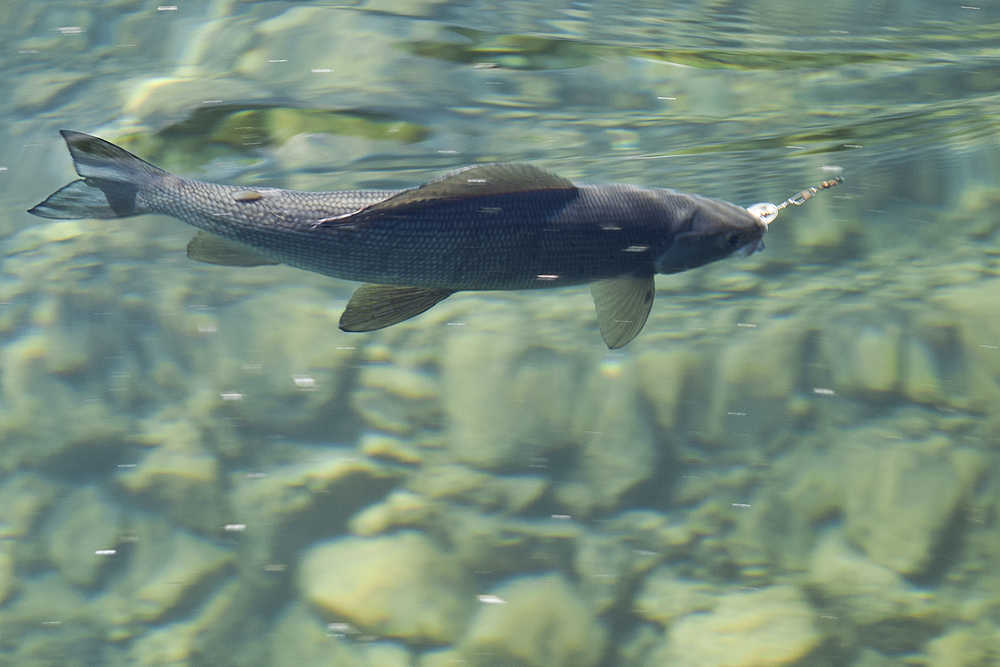From May through September, it can seem like there’s an angler every few feet along the banks of the Kenai Peninsula’s rivers.
Fortunately for anglers who don’t love elbow-to-elbow fishing, often wryly called “combat fishing,” there are other catches to be had on the peninsula. They may just take a little more work to reach.
To Amber Kraxberger-Linson, arctic grayling are one of those.
“They’re one of my favorites to fish for,” Kraxberger-Linson said. “They’re a very beautiful fish.”
Arctic grayling, sometimes called sailfish for their large dorsal fin, populate many of the lakes and tributary streams on the Kenai Peninsula. The relatively small fish come in a wide variety of colors and live in colder water bodies. Kraxberger-Linson, an interpretive park ranger at the Kenai National Wildlife Refuge, said she’ll hike up into the higher, more remote lakes to find them.
Though there are five kinds of grayling known, only arctic grayling live in Alaska. They live all over the state but tend to be more populous in the Interior rivers and streams. Their colors can vary from stream to stream, and they can tolerate the low-oxygen conditions in cold lakes that other fish can’t during the winter. Thus, they can live very long lives — some grayling can live to be 32 years old, according to the Alaska Department of Fish and Game.
They’re also notoriously voracious during the summer months. Dissections have shown prey in grayling stomachs ranging from aquatic insects to small mammals and salmon smolt — one particular fish had 65 chum salmon smolt in its stomach, according to Fish and Game.
“Fishing for grayling is not so much fishing as catching,” Kraxberger-Linson said. “They’ll bite at pretty much anything you put in front of them.”
One of the best places to look for grayling in lakes is near the inlet of streams, where the fish will queue up to catch food as it enters the lake. Grayling are a little different than other fish species because they will arrange themselves into a hierarchy, with the older, larger fish in the front and the smaller, younger fish behind.
Fishing for grayling is good while the water is warmer. In the winter, they conserve oxygen by drifting down to the bottom of the water and not feeding as much. Their energy picks up in the spring, peaking in the summer months.
Fly fishing for grayling with either dry or wet flies can be a fun way to catch them, though fly fishing tends to have a learning curve. Kraxberger-Linson said she tends to use a spinning rod because they’re easier to hike with up to the lakes where grayling tend to live, like Lower and Upper Fuller Lakes and Crescent Lake. Black and white jigs tend to work well, she said, though one thing to be aware of is the water’s clarity.
“The lakes in the mountains here are definitely going to be clear, so the fish are going to be spooky,” she said. “Avoid letting your shadow fall on the water.”
Anglers can take five per day with five in possession on the Kenai Peninsula. Fish and Game has historically stocked grayling from its William Jack Hernandez Sport Fish Hatchery in Anchorage but eliminated the fish from its stocking program during the 2016 season. The only lakes with stocked grayling on the Kenai Peninsula are Scout, Arc and Tirmore lakes, according to the 2016 statewide stocking plan. The other populations of grayling on the peninsula are wild.
Grayling are more expensive to raise in the hatcheries, and in light of state budget reductions, it made the most sense to suspend the grayling program, according to Fish and Game’s response to comments on its statewide stocking plan.
“The good news is that given the accessibility and sustainability of our Arctic grayling brood source (Chena River, Fairbanks) we will be able to reinstate our grayling program with relative ease when budgets allow,” Fish and Game’s response states.
Reach Elizabeth Earl at elizabeth.earl@peninsulaclarion.com.

